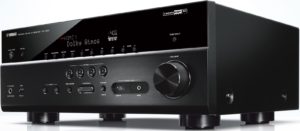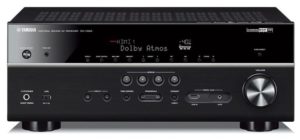The Verdict
Yamaha consistently pumps out good sounding AV equipment and this year’s Yamaha RX-V683 easily makes the cut. This amp has the finesse and brawn needed to breath new life into most home theaters.
Design: 8.5
Features: 8.5
Value: 8.5
Ease of Use: 8.0
Sound Quality: 8.5
Overall Score: 8.5
The Good
- The Yamaha RX-V683 offers good sound quality and an enviable set of features at a competitive price. Its substantial HDR video support is a big plus for 4K TV owners.
The Bad
- The 683’s connection choices are a little sparse. It has a solid amount of HDMI inputs, but compared to last year’s 681, it has very few analog inputs.
Yamaha has been at the top of their game the past few years. Sooner or later you expect them to have a misstep or two. However, that hasn’t happened yet. So far, we’ve reviewed three of this year’s models: the RX-V383, RX-V483, and the RX-V583 and none of them have disappointed. The Yamaha RX-V683 currently sits at the top of the RX line and like the previous models we’ve tested, it’s a great amalgam of features and performance.
Yamaha RX-V683 Design
Yamaha has maintained a consistent look across all of their amps for the past several years. The RX-V683 has a brushed aluminum treatment on the bottom half of its face. The top half is dominated by an easy to read, blue LED screen. You will find a little more button clutter on the face of the 683 than other receivers, but it’s not too noticeable. Once you place the receiver on a shelf or AV rack, the buttons just fade away.
Unfortunately, the button clutter also extends to the remote of the 683. Unlike the previous RX receivers we’ve tested, the remote of the Yamaha RX-V683 is a bit over-stuffed with buttons and takes a little while to get used to. In this regard, I wish that Yamaha would take a page from Onkyo’s and Sony’s playbooks and pare back the buttons a little. Yamaha’s AV Controller app allows you to use your smartphone as a remote. Via the app you can control most of the receiver’s features thru its slick interface. The onscreen menus are basically unchanged from last year’s model. They’re not as fancy as Sony’s GUI, but they get the job done.
Connectivity
HDMI, which delivers both audio and video, has supplanted many of the analog audio/video connectors we used to see. Despite this, the 683 has a couple RCA audio jacks and dedicated phono connectors for a turntable. It also has two coaxial and two optical digital inputs. Component inputs are slowly going extinct on mid-range amps, but you do get one on the 683. However, if you compare the 683 to last year’s 681, it comes up a little short with these legacy connections which could be a deal breaker for some.
For home automation scenarios, the 683 also has a 12V trigger and a remote IR input/output. The speaker connections receive a slight upgrade this year. All of them use 5-way binding posts, in contrast to last year’s model which only used spring clips for the Zone 2 speakers.
The 683 has a total of 6 HDMI hookups and 2 outputs. If you have a 4K TV or plan on upgrading to one soon, the Yamaha RX-V683 is in good shape to tackle UHD video. The HDMIs support most of the key 4K talking points. HDCP 2.2 and 4K video at 60/fps are both supported. High Dynamic Range video (HDR) is the “it” feature this year. The 683 is compatible with three different flavors of HDR – HDR10, Dolby Vision and Hybrid Log Gamma.
An ethernet port allows for wired network connections, however, most will probably decide to use the Yamaha 683’s built-in WiFi. In addition to WiFi, the Yamaha RX-V683 also allows for two-way Bluetooth communication. This means you can not only send a Bluetooth signal to the 683, but you can also send audio from the 683 to a set of Bluetooth headphones or speakers.
Streaming & Multi-Room
MusicCast is Yamaha’s pride and joy and for good reason. The app has grown more powerful since its launch. If you have MusicCast compatible speakers planted around your home, you can broadcast audio from the 683 to any of those devices.
The app plays host to a substantial list of streaming services including Tidal, Deezer, Spotify, Napster, SiriusXM, and Pandora. However, one thing won’t see on the 683 is Chromecast built-in. You can also stream music directly from your mobile device. If you happen to have an Apple handset or iPod, you can use AirPlay to send your tunes to the amp as well.
Setup
Yamaha uses their YPAO system for speaker calibration and it’s just as fast and easy as ever to use. Calibrating our system took only a couple minutes from start to finish. The 7-channel 683 is capable of pushing about 90 watts of power with 2-channels driven at 8 0hms. You can use two of its 7-channels for overhead or Atmos speakers. During setup you can select the type of speaker layout you’re using such as overhead, front height, or Dolby enabled. WiFi is easy to implement on the receiver, especially if you have an iOS device. If you do, you can easily copy your WiFi settings over to the Yamaha RX-V683 .
Speaker placement is the bane of many home theater enthusiasts. To remedy this, Yamaha uses magic to create surround sound without speakers present. Ok, not really, but it can sometimes seem like magic. Virtual Cinema Front lets you place your speakers in the front of the room and then the receiver bounces sound off your walls. The reflected sound can sometimes give the impression that you have surround speakers present. Virtual Cinema DSP behaves similarly, however it manages to achieve a similar effect with only two front channels. While this tech isn’t perfect, it does deliver an expansive sound field. If you’re lucky, sometimes an occasional sound or two will pop-up behind or next to your listening spot mimicking surround sound.
Sound Quality
One of the first movies I tasked the Yamaha RX-V683 with was Ghost in the Shell. I somehow missed this movie in the theater, but I heard it had a great action packed sound track. Since the audio was encoded in Dolby Atmos it seemed like the perfect test for the 683.
The Atmos sound track kicked into high gear on the Yamaha RX-V683 almost immediately. Bullets did a 3D sonic dance around our listening space. One of the first times that we see Scarlet Johansson’s character Major in action, she comes crashing through a window. The glass sparkled with 3-dimensional detail as it shattered. As you can probably tell, the 683 had no problem placing sound effects in 3-dimensional space. However, Atmos was more impressive when the protagonists were walking the futuristic city streets. The high-tech streets are dotted with towering 3-dimensional holographic advertisements. The audio from these giant ads and busy streets rose high overhead thanks to the Atmos soundtrack.
With music, the Yamaha RX-V683 was a solid if not spectacular performer. Vocals were clear and precise. Tonally, the amp has a very neutral sound with very little coloration. The 683 delivered just enough bass for Lorde’s Glory & Gore sound track without over doing it. As with most of Yamaha’s amps, you can try various pre programmed DSP settings for music such a Vienna or Munich Music Hall. I can’t say that I enjoy any of these presets and it makes me wonder if anyone truly uses them. Two channel stereo or seven channel playback typically ends up being my listening mode of choice. If you’re streaming music to the Yamaha 683, (and in this day and age most of us do) I recommend using Yamaha’s music enhancer. While it won’t raise compressed music to HD levels, it does add more body and fullness to these tracks.
The Verdict
The Yamaha RX-V683 didn’t give us a whole lot to complain about. The amp has most of the tech you’d expect to find in a mid-priced AV receiver. The biggest gripe we had was its lack of legacy connections. However, for most people, the number of component or RCA inputs a receiver has will probably rank pretty low on the list of must-haves.
Read more at: http://avproductreviews.com/yamaha-rx-v683-review
Where to buy Yamaha RX-V683: https://www.abtec.co.nz/product-search.php?keyword=V683&category=&brand=&search=




